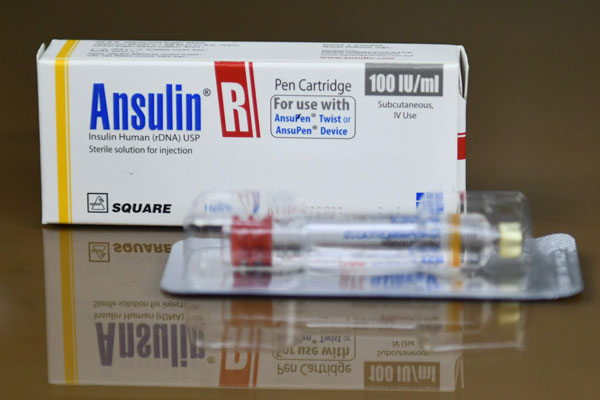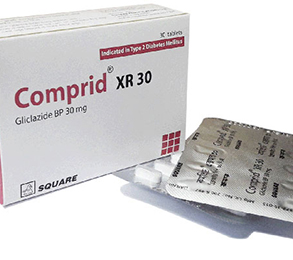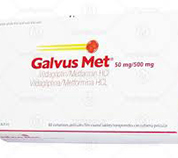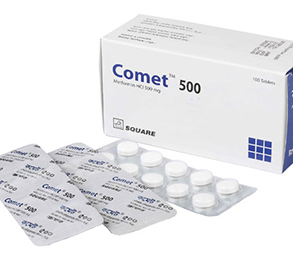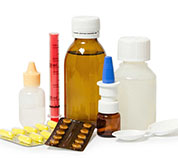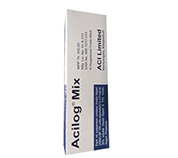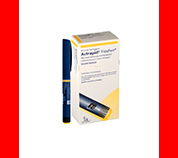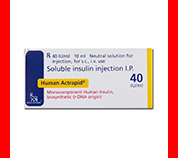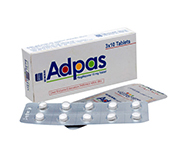Ansulin pen Cartridge R 1 Pc
Alternative products
Insulin Human
Indications
Treatment of all patients with type 1 diabetes. Treatment of patients with type 2 diabetes who are not adequately controlled by diet and/ or oral hypoglycemic agents. For the initial stabilization of diabetes in patients with diabetic ketoacidosis, hyperosmolar non-ketotic syndrome and during periods of stress such as severe infections and major surgery in diabetic patients. Treatment of gestational diabetes.
Pharmacology
The blood glucose lowering effect of insulin is due to the facilitated uptake of glucose following binding of insulin to receptors on muscle and fat cells and to the simultaneous inhibition of glucose output from the liver. Insulatard is a long-acting insulin. Onset of action is within 1½ hours, reaches a maximum effect within 4-12 hours and the entire time of duration is approximately 24 hours.
Insulin in the blood stream has a half-life of a few minutes. Consequently, the time-action profile of an insulin preparation is determined solely by its absorption characteristics. This process is influenced by several factors (e.g. insulin dosage, injection route and site, thickness of subcutaneous fat, type of diabetes). The pharmacokinetics of insulins is therefore affected by significant intra- and inter-individual variation
Dosage
Dosage is individual and determined in accordance with the needs of the patient. The individual insulin requirement is usually between 0.3 and 1.0 IU/kg day. The daily insulin requirement may be higher in patients with insulin resistance (e.g. during puberty or due to obesity) and lower in patients with residual, endogenous insulin production.
The physician determines one or several daily injections are necessary. Insulatard may be used alone or mixed with fast-acting insulin. In intensive insulin therapy the suspension may be used as basal insulin (evening and/or morning injection) with fast-acting insulin given at meals. In patients with diabetes mellitus optimised glycaemic control delays the onset of late diabetic complications. Close blood glucose monitoring is recommended.
* চিকিৎসকের পরামর্শ মোতাবেক ঔষধ সেবন করুন'
Administration
For subcutaneous use. Insulatard is usually administered subcutaneously in the thigh. If convenient, the abdominal wall, the gluteal region or the deltoid region may also be used. Subcutaneous injection into the thigh results in a slower and less variable absorption compared to the other injection sites. Injection into a lifted skin fold minimises the risk of unintended intramuscular injection.
Keep the needle under the skin for at least 6 seconds to make sure the entire dose is injected. Injection sites should be rotated within an anatomic region in order to avoid lipodystrophy. Insulin suspensions are never to be administered intravenously. Insulatard is accompanied by a package leaflet with detailed instruction for use to be followed. The vials are for use with insulin syringes with corresponding unit scale. When two types of insulin are mixed, draw the amount of fast-acting insulin first, followed by the amount of long-acting insulin
* চিকিৎসকের পরামর্শ মোতাবেক ঔষধ সেবন করুন'
Interaction
A number of medicinal products are known to interact with the glucose metabolism. Physicians must therefore take possible interactions into account and should always ask their patients about any medicinal products they take.
The following substances may reduce insulin requirement: Oral hypoglycaemic agents (OHA), monoamine oxidase inhibitors (MAOI), non-selective beta-blocking agents, angiotensin converting enzyme (ACE) inhibitors, salicylates and alcohol.
The following substances may increase insulin requirement: Thiazides, glucocorticoids, thyroid hormones and beta-sympathomimetics, growth hormone and danazol. Beta-blocking agents may mask the symptoms of hypoglycaemia and delay recovery from hypoglycaemia. Octreotide/lanreotide may both decrease and increase insulin requirement. Alcohol may intensify and prolong the hypoglycaemic effect of insulin.
Contraindications
Hypoglycaemia, Hypersensitivity to human insulin or to any of the excipients
Side Effects
Hypoglycemia is the most common adverse effect during insulin treatment and symptoms of hypoglycemia may occur suddenly. Few cases of the allergic reaction such as red and swollen or itching are reported. It usually disappears in a few days. In some instances, the allergy may be caused by other reasons rather than insulin, such as disinfectant and poor injection technique.
Pregnancy & Lactation
There are no restrictions on treatment of diabetes with insulin during pregnancy, as insulin does not pass the placental barrier.
Precautions & Warnings
Inadequate dosage or discontinuation of treatment, especially in type 1 diabetes, may lead to hyperglycaemia. Usually the first symptoms of hyperglycaemia set in gradually, over a period of hours or days. They include thirst, increased frequency of urination, nausea, vomiting, drowsiness, flushed dry skin, dry mouth, loss of appetite as well as acetone odour of breath In type 1 diabetes, untreated hyperglycaemic events eventually lead to diabetic ketoacidosis, which is potentially lethal. Hypoglycaemia may occur if the insulin dose is too high in relation to the insulin requirement
Omission of a meal or unplanned, strenuous physical exercise may lead to hypoglycaemia. Patients whose blood glucose control is greatly improved e.g. by intensified insulin therapy, may experience a change in their usual warning symptoms of hypoglycaemia and should be advised accordingly Usual warning symptoms may disappear in patients with longstanding diabetes.
Overdose Effects
A specific overdose of insulin cannot be defined. However, hypoglycaemia may develop over sequential stages
Therapeutic Class
Long Acting Insulin
Storage Conditions
Store in a refrigerator (2°C-8°C). Do not freeze. Keep the container cartridge or vial in the outer carton in order to protect from light.
During use: do not refrigerate. Do not store vials above 25°C and cartridges above 30°C. Protect from excessive heat and sunlight.
- Type Injection
- Tag
- Morbi leo risus
- Porta ac consectetur ac
- Vestibulum at eros
